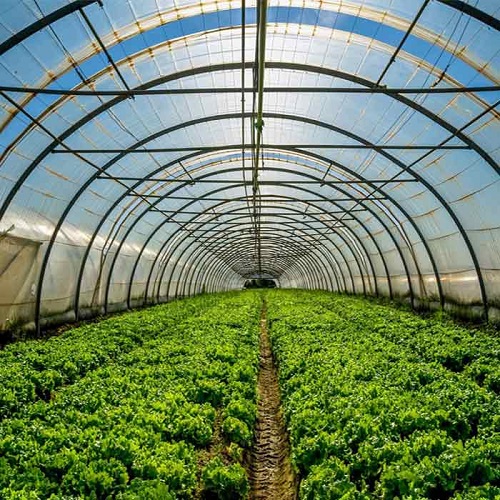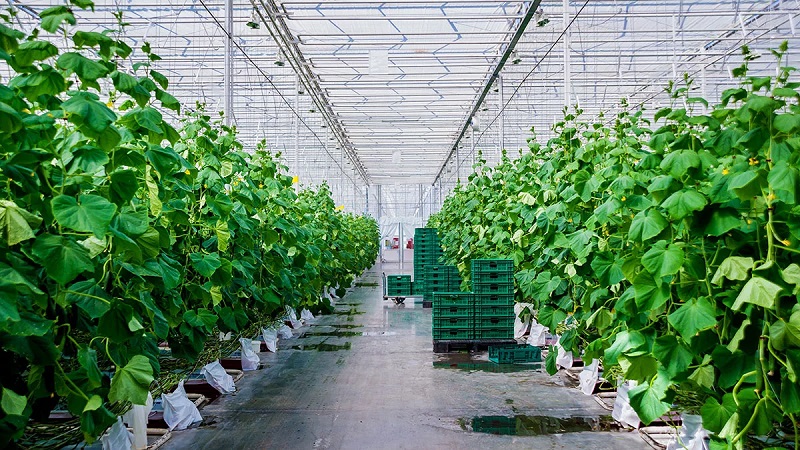
Everything you should know about fertilizing greenhouse plants
In recent decades, greenhouse cultivation has become one of the most popular methods for growing plants. Greenhouses provide the necessary conditions to cultivate any type of flower, plant, or fruit in a controlled environment. Fertilizing greenhouse plants comes with its own specific conditions and regulations. This article will explain the types of fertilizers needed for greenhouse plants and how to fertilize them effectively.
The Importance of Nutrition for Greenhouse Plants
Greenhouse farming enables the cultivation of a wide range of horticultural and agricultural products outside of their typical growing season. However, the continuous use of greenhouse cultivation substrates reduces the essential nutrients available to the plants. Therefore, fertilizing greenhouse plants is necessary to make up for this deficiency.
We need to prioritize the nutrition of greenhouse plants to ensure they grow well. Providing the proper nutrition not only maximizes plant productivity but also helps prevent soil compaction and certain plant diseases. It’s important to note that the nutrient requirements differ for each plant in a greenhouse. Therefore, it’s essential to identify and use specific fertilizers for each type of plant, rather than relying on a single fertilizer for all the different types of greenhouse plants.
Choosing the appropriate and correct fertilizer ensures that plants have the best possible growth and produce more and higher-quality products. Fertilizing greenhouse plants should be balanced. Greenhouse cultivation can evolve into an effective agricultural method by following fertilization guidelines and providing a suitable growth environment.

Types of Fertilizers for Greenhouse Plants
As we mentioned, fertilizing greenhouse plants is important and needs to be done carefully. In a broad classification, greenhouse fertilizers can be divided into two categories: organic fertilizers and chemical fertilizers.
Organic Fertilizers
Organic fertilizers are natural and biological nutrients used to increase soil fertility and provide plants with essential nutrients. These fertilizers are derived from natural sources and include the following:
- Animal manure (such as cow, sheep, poultry, horse manure, etc.)
- Plant-based fertilizers (such as compost, vermicompost, green manure, etc.)
- Commercial organic fertilizers (such as processed animal-based fertilizers, processed plant-based fertilizers, etc.)
Organic fertilizers require more time to break down. Therefore, plant absorption of these fertilizers takes longer. The use of organic and animal fertilizers helps improve soil structure and enhances the uptake of other elements in plants.
Compared to chemical fertilizers, organic fertilizers not only provide nutrients but also improve soil structure and increase beneficial soil microorganisms. This leads to increased soil fertility and water retention capacity. Additionally, organic fertilizers convert organic matter into mineral forms that are readily absorbable by plants, promoting growth and agricultural productivity.
Poultry manure is one of the most popular organic fertilizers used in greenhouses due to its high levels of nitrogen, phosphorus, and potassium, making it highly nutritious.
Chemical Fertilizers
Chemical fertilizers are industrially produced fertilizers made using chemical processes. These fertilizers contain pure mineral compounds necessary for plants. Unlike organic fertilizers, chemical fertilizers do not need to decompose; therefore, nutrients are directly available to plants and are quickly absorbed. Types of chemical fertilizers include nitrogen-based fertilizers, phosphate fertilizers, potassium fertilizers, etc.
Chemical fertilizers are more easily absorbed by plants than organic fertilizers, promoting rapid growth and higher agricultural yield. However, overuse can lead to environmental pollution and harm plants. Therefore, they should be used judiciously, taking into account the specific needs of the plants.
Classification of Greenhouse Fertilizers Based on Consumption Levels
Greenhouse fertilizers used by plants are divided into two categories based on consumption levels:
- NPK fertilizers(macronutrients)
- trace minerals fertilizers (micronutrients)
Elements greenhouse plants need the most (macronutrients)
Macro elements (high consumption) are six elements that exist in large quantities in plants. Nitrogen, phosphorus, potassium, calcium, sulfur, and magnesium are the macro elements greenhouse plants need the most when it comes to fertilizing. Different types of fertilizers exist to supply these elements, and the required fertilizer should be applied based on the type of plant and its needs.
- Nitrogen: Plants require nitrogen more than any other element. This element contributes to plant growth, greenness, and product quality improvement. Nitrogen is a major component of plant proteins. Therefore, with increased nitrogen, the synthesis of proteins and enzymes essential for plant vital activities increases. Strengthening roots and increasing resistance to stresses are among the other benefits of providing nitrogen to plants. Urea and ammonium sulfate fertilizer, and ammonium nitrate fertilizer are primary sources of nitrogen for plants and trees. The nitrogen requirement of each plant varies; to determine the required nitrogen levels for a plant and its consumption doses, consult with an agricultural expert or experienced farmer.
- Phosphorus: Phosphorus is another macro element necessary for plants especially if it’s used as fruit tree fertilizers. This fertilizer promotes root expansion and increases fruit tree productivity. This element plays a fundamental role in energy transfer and storage in plants. The synthesis and transfer of sugars and increased resistance to environmental stresses are the most significant effects of phosphorus. Phosphorus and iron in the soil affect each other in a way that an increase in phosphorus leads to iron deficiency and an excess of iron results in phosphorus deficiency.
- Potassium: Potassium fertilizers play a preservative role in plants. Potassium thickens the outer layer of the cuticle. Potassium deficiency in plants can make greenhouse plants brittle. In the case of potassium deficiency, the likelihood of pest infestations, insects, and fungi increases. Potassium aids in the opening and closing of stomata, a process crucial for plant transpiration, photosynthesis, and respiration.
- Calcium: Calcium plays a role in forming plant cell walls and cell membranes. This element creates strength and structural integrity in plants. Calcium regulates important processes such as cell division, cell elongation, root formation, and flower and fruit growth. This element helps plants become more resistant to many fungal and bacterial diseases. Overall, calcium plays a crucial role in structural strength, regulating physiological processes, and resistance to environmental stresses. Calcium deficiency can lead to reduced plant growth and increased susceptibility to diseases.
- Magnesium: The role of magnesium in plant growth includes functions in photosynthesis, energy transfer and storage, cell division, root growth, and the regulation of stomatal opening and closing. Magnesium deficiency causes chlorosis between leaf veins in mature leaves and dries out leaves. In some plants, an increase in potassium leads to magnesium deficiency, so potassium prevents magnesium absorption. The lower the magnesium in a plant, the more its growth decreases.
- Sulfur: Sulfur is another macro element necessary for greenhouse plants. Sulfur improves photosynthesis, increases protein synthesis, enhances product quality, boosts resistance to diseases, and improves the absorption of other elements. Ammonium sulfate is one of the best agricultural fertilizers that provide the necessary nitrogen and sulfur for plants. This fertilizer is produced in various forms, with ammonium sulfate crystals being one of the most widely used types.

Elements Greenhouse Plants need less (micronutrients)
There are 6 macronutrients (trace minerals) that are present in plants in lower amounts but are essential for the health of the plant. Iron, zinc, manganese, copper, boron, and molybdenum are micronutrients that plants require.
- Iron: Iron plays a key role in plant physiological processes. This element is involved in the production of chlorophyll, the electron transfer chain in photosynthesis, cellular respiration, protein synthesis, and enzymatic activities of the plant.
- Manganese: Manganese is part of enzymatic proteins involved in photosynthesis and water-splitting processes. Manganese is part of oxidizing enzymes like superoxide dismutase, which plays a role in protecting cells against oxidative damage. This element is effective in protein and nucleic acid synthesis, metabolic reactions related to carbohydrates, and the production and growth of flowers and fruits. Manganese deficiency in plants can lead to symptoms such as leaf chlorosis, reduced growth, and delays in flowering and fruiting.
- Zinc: Zinc is an enzyme that is essential for many activities. These enzymes play a role in plant metabolic processes. This element is essential for the synthesis and proper functioning of proteins in plants. Zinc plays a role in the production of plant hormones such as auxins, gibberellins, and cytokinins, which are vital for the growth and development of plants. Additionally, the presence of this element is crucial for the production of chlorophyll, leaf greening, and increasing plant resistance to environmental stresses such as drought, soil salinity, and pollution. Zinc deficiency in plants can lead to symptoms such as stunting, leaf chlorosis, reduced root and stem growth, and decreased yield.
- Copper: Copper is essential for the synthesis of lignin, which is a structural component of plant cell walls. The copper element plays a role in the synthesis of some pigments such as lignin and melanin. This element is essential for the synthesis and activity of some plant hormones like ethylene. Additionally, copper is necessary for the formation and strength of plant cell walls. Copper deficiency in plants can lead to symptoms such as chlorosis, leaf scorch, reduced growth, reduced flowering, and yield. Therefore, ensuring an adequate supply of copper for plants is crucial.
- Molybdenum: Molybdenum is part of the enzyme nitrogenase, which plays a crucial role in the process of nitrogen fixation by plants. This process is essential for the growth and development of plants. Molybdenum plays a role in the metabolism of nitrogen compounds such as nitrates and ammonia. Molybdenum is present in the structure of many enzymes and regulates their function. Other effects of this element include flower and fruit formation and its impact on photosynthetic reactions. Molybdenum deficiency in plants can lead to symptoms such as leaf chlorosis, reduced growth, decreased flowering and fruiting, and problems in nitrogen metabolism. Therefore, ensuring an adequate supply of molybdenum for plants is of utmost importance.
Formulation of Fertilization for Greenhouse Plants
Monitoring soil pH is crucial in greenhouse management as it directly impacts plant nutrient uptake and overall growth. Along with temperature, humidity, and light levels, soil pH plays a vital role in determining plant performance. Additionally, fertilization is essential for addressing any soil nutrient deficiencies, and various types of fertilizers, including organic, chemical, and biological options, are commonly used in greenhouse settings.
In fertilizing greenhouse plants, both macro and micronutrients should be applied to the greenhouse in a balanced manner. Adhering to the proper fertilization levels for greenhouse plants and maintaining ideal environmental conditions helps regulate soil pH.
The soil in a greenhouse requires more macronutrients, such as nitrogen, phosphorus, and potassium, compared to micronutrients. Macronutrients are essential for cell growth, energy transfer, and regulation of physiological processes. On the other hand, micronutrients like iron and manganese support plant biochemical processes and contribute to chlorophyll production and enzymatic activity.
Changes in these components, whether due to their absence or increase, can result in plant death, stunted growth, or plant diseases. This makes it essential to comprehend the specific soil needs for each of these components and then apply fertilizers to the plants accordingly. To identify the fertilization requirements of the greenhouse, samples of both soil and plants need to be collected. These samples are then analyzed in soil and plant testing laboratories to precisely determine the particular needs of the greenhouse. Based on this information, different fertilizers are chosen to fulfill the plants’ needs. For example, during the growing season, plants require more nitrogen, which should be applied to the plants at specific intervals.be applied to the plants at specific intervals.
Having a regular schedule for fertilizing greenhouse plants is vital. Consistent and small doses of fertilizers yield better results compared to infrequent large doses. Over time, nutrients become available to the plants, minimizing nutrient deficiencies.
